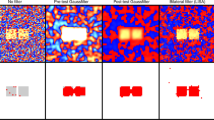Abstract
Detection of active areas in a human brain by functional magnetic resonance imaging (fMRI) is a challenging problem in medical imaging. Moreover, determining the onset and end of activation signals can determine temporal relationships required for brain mapping. In this paper, a comparative study for detecting active areas in fMRI data using Bayesian and classical approaches was introduced. It has been found that using Bayesian model provides accurate and sensitive detection.
Access this chapter
Tax calculation will be finalised at checkout
Purchases are for personal use only
Preview
Unable to display preview. Download preview PDF.
Similar content being viewed by others
References
H.S. Zadeh, D.J. Peck, D.O. Hearshen, and R.R. O’Neill, “Model-Independent Method for fMRI Analysis,” IEEE Trans. on Med. Imag., vol. 23, no. 3, pp. 285–296, Mar. 2004.
A. Connelly, “Ictal imaging using functional magnetic resonance,” Magn. Reson. Imag., vol. 13, no. 8, pp. 1233–7, 1995.
A. Villringer and U. Dirnagl, “Coupling of brain activity and cerebral blood flow: Basis of functional neuroimaging,” Cerebrovasc. Brain Metabol. Rev., vol. 7, pp. 240–276, 1995.
S. Kim, W. Richter, and K. Ugurbil, “Limitations of temporal resolution in functional MRI,” Magn. Reson. Med., vol. 37, pp. 631–636, 1997.
O. Henriksen, H. W. Larsson, P. Ring, and E. Rostrup, Acta Radiologica, vol. 34, pp. 101–103, 1993.
O. Friman, J. Cedefamn, P. Lundberg, M. Borga, and H. Knutsson, “Detection of neural activity in functional MRI using canonical correlation analysis,” Magn. Reson. Med., vol. 45, pp. 323–330, 2001.
K. Friston, P. Jezzard, and R. Turner, “Analysis of functional MRI time series,” Human Brain Mapping, vol. 1, pp. 153–171, 1994.
E. Bullmore, M. Brammer, S. Williams, S. Rabe-Hesketh, N. Janot, et al, “Statistical methods of estimation and inference for functional MRI analysis,” Magn. Reson. Med., vol. 35, pp. 261–277, 1996.
U.E. Ruttimann, M. Unser, R.R. Rawlings, D. Rio, N.F. Ramsey, et al, “Statistical analysis of functional MRI data in the wavelet domain,” IEEE Trans. Med. Imag., vol. 17, pp. 142–154, Apr. 1999.
L.R. Frank, R.B. Buxton, and E.C. Wong, “Probabilistic analysis of functional magnetic resonance imaging data,” Magn. Reson. Med., vol. 39, pp. 132–148, 1998.
B. Ardekani, J. Kershaw, K. Kashikura, and I. Kanno, “Activation detection in fMRI using subspace modeling and maximum likelihood estimation,” IEEE Trans. Med. Imag., vol. 18, pp. 101–114, Feb. 1999.
M.J. Fadili, S. Ruan, D. Bloyet, and B. Mazoyer, “Unsupervised fuzzy clustering analysis of fMRI series,” Proc. 20th Annu. Int. Conf. IEEE-EMBS, vol. 20, no. 2, pp. 696–699, 1998.
R. Baumgartner, L. Ryner, W. Richter, R. Summers, M. Jarmasz, and R. Somorjai, “Comparison of two exploratory data analysis methods for fMRI: Fuzzy clustering vs. principal component analysis,” Magn. Reson. Med., vol. 18, pp. 89–94, 2000.
J. Stone, J. Porrill, N. Porter, and I. Wilkinson, “Spatiotemporal independent component analysis of event-related fMRI data using Skewed probability density functions,” NeuroImage, vol. 15, pp. 407–421, 2002.
S. Ngan and X. Hu, “Analysis of functional magnetic resonance imaging data using self-organizing mapping with spatial connectivity,” Magn. Reson. Med., vol. 41, pp. 939–946, 1999.
The department of imaging neuroscience at the Institute of Neurology at University College of London; available http://www.fil.ion.ucl.ac.uk/spm/data#fMRI_MoAEpilot.
K. Friston, P. Jezzard, and R. Turner, “Analysis of functional MRI timeseries,” Human Brain Mapping, vol. 1, pp. 153–171, 1994.
J. Ashburner, K. Friston, W. Penny, “Human Brain Function”, 2nd edition 2002.
K. Friston, W. Penny, C. Phillips, S. Kiebel, G. Hinton, et al, “Classical and Bayesian inference in neuroimaging: Theory,” NeuroImage, vol.16, pp. 465–483, 2002.
V. Calhoun, M. Stevens, G. Pearlson, and K. Kiehl, “fMRI analysis with the general linear model: removal of latency-induced amplitude bias by incorporation of hemodynamic derivative terms,” NeuroImage, Vol. 22, pp. 252–257, 2004.
K.J. Friston, K.J. Worsley, R.S., Frackowiak, J.C., Mazziotta, and A.C. Evans, “Assessing the significance of focal activations using their spatial extent,” Hum. Brain Mapp. Vol. 1, pp. 214–220, 1994.
P.A. Bandettini, A. Jesmanowicz, E.C. Wong, and J.S. Hyde, “Processing strategies for time course data sets in functional MRI of the human brain,” Mag. Res. Med. vol. 30, pp. 161–173, 1993.
R. Bracewell, The Fourier transform and its applications. McGraw-Hill International Editions, 2nd edition, 1986.
P. Purdon and R. Weisskoff, “Effects of temporal autocorrelation due to physiological noise and stimulus paradigm on voxel-level false-positive rates in fMRI,” Human Brain Mapping, vol. 6, pp. 239–249, 1998.
K. Worsley and K. Friston, “Analysis of fMRI time series revised-again,” Neuroimage, vol. 2, pp. 173–181, 1995.
R.V. Alexandre and W.O. Gary, “Bayesian Image Analysis of fMRI Brain Data Sets,” School of Statistics, University of Minnesota, March 2000.
W. Mark, J. Mark, J. Brady, and M. Stephen, “Fully Bayesian Spatio-Temporal Modeling of FMRI Data,” IEEE, Trans. on Med. Imaging, vol. 23, no. 2, pp. 213–231, Feb. 2004.
G. Newell, and E. Montroll, “On the Theory of the Ising Model of Ferromagnetism,” Reviews of Modern Physics, vol.25, pp. 353–389, 1953.
Author information
Authors and Affiliations
Corresponding author
Editor information
Rights and permissions
Copyright information
© 2007 International Federation for Medical and Biological Engineering
About this paper
Cite this paper
Mohamed, M.A., Abou-Chadi, F., Ouda, B.K. (2007). Analysis of fMRI Data Using Classical and Bayesian Approaches: A Comparative Study. In: Magjarevic, R., Nagel, J.H. (eds) World Congress on Medical Physics and Biomedical Engineering 2006. IFMBE Proceedings, vol 14. Springer, Berlin, Heidelberg. https://doi.org/10.1007/978-3-540-36841-0_221
Download citation
DOI: https://doi.org/10.1007/978-3-540-36841-0_221
Publisher Name: Springer, Berlin, Heidelberg
Print ISBN: 978-3-540-36839-7
Online ISBN: 978-3-540-36841-0
eBook Packages: EngineeringEngineering (R0)




